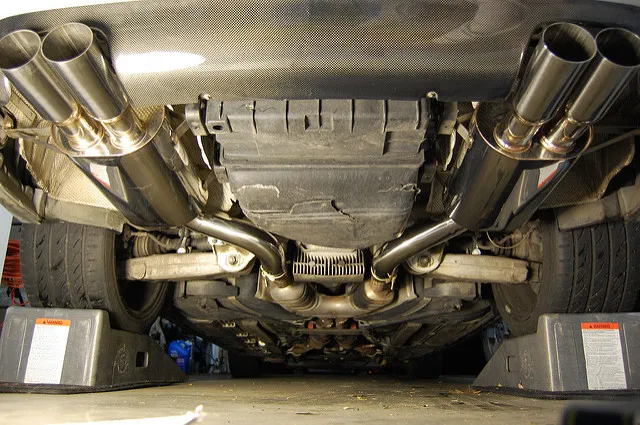Canada’s greenhouse gas (GHG) emissions regulations for passenger vehicles currently adopt by default the standards of the U.S. Environmental Protection Agency (EPA). Since this marriage in 2012, Canada and the United States have had an amazing run. But all signs now point to irreconcilable differences, and it’s time to file the paperwork for a vehicle standards divorce.
Canada-U.S. cooperation on vehicle standards hit a speed bump on April 2, after Scott Pruitt, administrator of the EPA, announced a reopening of the midterm evaluation for GHG emissions standards for cars and light trucks for model years 2022 to 2025, stating that current standards are not appropriate and should be revised. The Trump administration’s intentions with this review are clear: to weaken GHG emissions and fuel economy standards for automobiles, handing a victory to the gasoline-fuelled-car lobby.
California and 15 other states plus Washington, D.C., have the right to set their own emissions standards under section 177 of the U.S. Clean Air Act. The response from California Governor Jerry Brown was unequivocal: he called the EPA’s decision a “cynical and meretricious abuse of power” that will “jeopardize the health of all Americans.” Similarly, responses from other states were swift and made it clear they were ready to stand and fight.
This announcement has serious implications for Canada. Environment and Climate Change Canada’s regulations incorporate the U.S. EPA’s rule by reference, so if the EPA relaxes its standards, Canada’s regulations are automatically weakened. To keep our own regulations strong and achieve our 2030 emissions targets, Canada needs to split from the U.S. federal regulations or consider cozying up to California, to maintain the current stringency of the standards to 2025.
Canada’s emissions regulations
The Passenger Automobile and Light Truck Greenhouse Gas Emission Regulations were published in October 2010. They establish progressively more stringent GHG emissions standards for new light-duty vehicles sold in Canada in model years 2011 to 2025, in alignment with the U.S. national standards.
The regulations are flexible, providing automobile manufacturers with several options to comply with average emissions reduction targets for their fleets: for instance, they can generate and earn credits for overcompliance or for selling more zero-emissions vehicles. Thus, the regulations also help Canada achieve the goal of putting more zero-emissions vehicles on the road.
The GHG emissions regulations are essential to offset population growth, the ever-growing fleet of gasoline vehicles on our roads and the large number of high-emitting vehicles in that fleet.
Transportation emissions trends in Canada
The transportation sector contributes a quarter of Canada’s total GHG emissions. Given this sizable piece of the carbon pollution pie, it’s critical that we not lose any momentum on reducing transportation emissions. It is expected that Canada will add more than 2 million passenger vehicles in 2018. Canadian consumers, influenced by the auto industry’s marketing, are also choosing to buy heavy, high-emitting vehicles. Light trucks represent over 70 per cent of new vehicles sold annually in Canada.
This is why vehicle emissions regulations are so important. Under these regulations, Canadian consumers can be assured that their next vehicle will be more fuel efficient than the previous one. It is projected that cars for model year 2025 will consume up to 50 per cent less fuel than 2008 models. According to Environment and Climate Change Canada, “On average, a Canadian driving a model year 2025 vehicle will realize fuel savings of around $900 per year compared to driving today’s new vehicles.”
While carbon pricing affects people’s driving behaviour as measured in distance travelled (people travel less when gasoline prices go up), it will have little impact on changing consumers’ preference for high-emitting vehicles, unless we reform the federal excise tax on fuel-inefficient vehicles, as discussed in Policy Options in July 2017.
Compliance with the standards makes good business sense
For the first five years of the regulations (2011 to 2015), Environment and Climate Change Canada reported overcompliance with the regulations by the industry, with the average GHG emissions for the fleet consistently lower than the prescribed standards in the regulations. Evidently, automobile manufacturers have developed and deployed a variety of advanced technologies and innovations to reduce emissions.
The ability to earn and bank credits for overcompliance is an important aspect of the regulations and helps manufacturers to transition to the stricter standards for the 2017-25 model years. It allows manufacturers to plan and implement an orderly phase-in of emissions control technology.
Concerns about high costs of compliance have been consistently overstated. Developments reported by suppliers suggest that costs for some of the new technologies will decline by hundreds of dollars, and electric vehicle costs will drop by thousands of dollars per vehicle by 2025. Research in 2017 by the International Council on Clean Transportation (ICCT) demonstrates that “compliance costs for the adopted 2025 standards will be 34% to 40% lower than projected in the latest U.S. midterm evaluation regulatory analysis.”
The ICCT’s research also demonstrates that the current standards “can be achieved cost-effectively. Such standards would result in modest, gradual vehicle price increases through 2030, and with two to three times greater consumer fuel savings than costs” (emphasis added). The current standards “could be achieved mostly with advanced combustion technology, while also spurring growth in the plug-in electric vehicle segment of the market.”
And in fact, some sectors of the Canadian automobile industry see it that way; they are concerned about the impacts of potentially weakening the standards. Canada’s Automotive Parts Manufacturers’ Association says that “making the rules less stringent will hurt the finances of car part manufacturers in Canada who have been preparing for the tougher standards.” Flavio Volpe, president of the APMA, says, “We have been investing hundreds of billions of dollars in lightweighting and also alternative propulsion. If that standard is lowered, at this late stage, in some cases, it threatens to strand some of that advanced research and development spending.”
Given the relatively slow pace of change in a world as large and complex as the automotive sector, GHG emissions regulations were set for the medium term and long term, not to respond to short-term political pressures. Predictability in regulations and stronger air quality and GHG emissions regulations over the longer term are essential to enable the industry to compete in the global low-carbon economy. The need for such conditions represents one more powerful argument for Canada to maintain the current regulations through 2025.
These regulations are essential to meeting our international climate obligations
The most recent amendments to the Canadian vehicle standards were expected to bring a cumulative decrease of 174 megatonnes (Mt) in GHG emissions between 2017 and 2025, according to Environment and Climate Change Canada. This is a decrease we cannot afford to lose if we want to stand a chance of meeting our Paris Agreement commitments. Recent projections show that Canada is on track to fall 66 Mt short of its 2030 Paris target, and these projections assume no change to the current vehicle emissions regulations through 2025.
It’s time for Canada to start drafting the divorce papers and establish our own, Canada-specific regulations to maintain the current schedule of emissions targets. These regulations are essential for responding to the urgent climate crisis, ensuring that Canadian car manufacturers can compete in the global low-carbon economy and saving consumers money.
And we see potential for Canada and California to tie the knot, as California has clearly stated its intention to keep pushing further on climate policy and has no interest in weakening its existing regulation. Together, Canada, California and the other 15 states represent close to half of the North American car market. Our next great relationship may be just around the corner.
Annie Bérubé is the director of government relations in Équiterre’s Ottawa office
Isabelle Turcotte is senior analyst at the Pembina Institute









